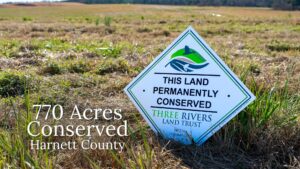

For the second year in a row, Three Rivers Land Trust has hosted a great event in partnership with the Pee Dee National Wildlife Refuge in Anson County. JD Bricken, refuge manager, has provided attendees with a special viewing of ducks in a section of the wildlife refuge that is normally closed to the public from November until March as a waterfowl sanctuary.
Approximately 12 attendees joined us for this event on January 31st. It was a brisk 18 degrees when we met at the new refuge office off Highway 52 near Wadesboro. I gave a short talk about the land trust’s mission and the JD gave an introduction to the refuge, before the group consolidated into 4 cars and headed in the direction of the Griffin Lowlands.
When the group arrived there, the ducks were not. JD quickly recommended that we ride over to the Richmond County side of the refuge, stating that the ducks usually frequent one side or the other. After a bit of a drive, we arrived to the area in Richmond County and were not disappointed. There were thousands of ducks that took flight upon our arrival. We were able to see black ducks, mallards, scaup, gadwall, pintail, and a few other species all within about a 30 minute interval. There was also a bald eagles nest and the eagle was perched upon a branch nearby.
This situation made for the perfect opportunity to get some great shots of these birds in migration, and several attendees had brought cameras with them and were able to get some fantastic pictures. In particular, I was able to get some great shots of a northern pintail.
The northern pintail is a large duck with a wide range. They breed in northern Europe, Asia, and North America. They are a migratory bird, and winter south of their breeding range all the way to the equator. The male duck’s long central tail feathers are where the species gets its name. The male has a brown head and white breast with a white stripe extending to the head. The back is blackish-gray and their rump has a white patch on each side. The bill is blue-grey with a black stripe down the center. The pintail is a dabbling duck, which means it feeds on the surface in shallow water. They are one of the earliest nesting ducks in North America.
They are described as elegant ducks with a long neck. They are sometimes called the “greyhound of the air.” Pintails were once one of the most abundant birds in North America, but have suffered a decline since the 1950s, mostly due to habitat loss and drought, as well as avian diseases. They are still one of the most numerous duck species in the world as they cover such a large range.
One of my co-workers shot a banded pintail while duck hunting last year, which is very uncommon. He was on this birding trip and was excited when I got the great picture of the pintail. If you missed this year’s birding trip at the Pee Dee National Wildlife Refuge, we will have this event again next year in late January or early February, the best time to see the ducks at the refuge. Keep an eye out for this and other great events on our website at www.threeriverslandtrust.org.